Ideology. Marius S. Ostrowski
Чтение книги онлайн.
Читать онлайн книгу Ideology - Marius S. Ostrowski страница 4
 style="font-size:15px;"> 182 174
style="font-size:15px;"> 182 174183 175
184 176
185 177
186 178
187 179
188 180
189 181
190 182
191 183
192 184
193 185
194 186
195 187
196 188
197 189
198 190
199 191
200 192
201 193
202 194
203 195
204 196
205 197
206 198
207 199
Ideology
Marius S. Ostrowski
polity
Copyright Page
Copyright © Marius S. Ostrowski 2022
The right of Marius S. Ostrowski to be identified as Author of this Work has been asserted in accordance with the UK Copyright, Designs and Patents Act 1988.
First published in 2022 by Polity Press
Polity Press
65 Bridge Street
Cambridge CB2 1UR, UK
Polity Press
101 Station Landing
Suite 300
Medford, MA 02155, USA
All rights reserved. Except for the quotation of short passages for the purpose of criticism and review, no part of this publication may be reproduced, stored in a retrieval system or transmitted, in any form or by any means, electronic, mechanical, photocopying, recording or otherwise, without the prior permission of the publisher.
ISBN-13: 978-1-5095-4072-3
ISBN-13: 978-1-5095-4073-0 (pb)
A catalogue record for this book is available from the British Library.
Library of Congress Control Number: 2021948304
by Fakenham Prepress Solutions, Fakenham, Norfolk NR21 8NL
The publisher has used its best endeavours to ensure that the URLs for external websites referred to in this book are correct and active at the time of going to press. However, the publisher has no responsibility for the websites and can make no guarantee that a site will remain live or that the content is or will remain appropriate.
Every effort has been made to trace all copyright holders, but if any have been overlooked the publisher will be pleased to include any necessary credits in any subsequent reprint or edition.
For further information on Polity, visit our website: politybooks.com
Figures and Tables
Figures
1 The history of ideology theory
2 An overview of ideologies’ historical development
3 The ideological compass
4 Ideological apparatuses’ operations over the life cycle
5 Sources of ideological influence
6 The ideology studies compass
Tables
1 The criteria of ideological characterisation
2 Social domains
3 Overview of ideologies’ social morphologies
4 Ideological apparatuses across social domains
Preface
In 1967, in his essay ‘Negative and Positive Freedom’, the philosopher Gerald MacCallum put forward a deceptively simple but at the time profoundly radical claim: that the idea of freedom referred to a single concept. To understand the radicalism of MacCallum’s proposition, we have to recall its intellectual context. Under the shadow of recent and ongoing conflicts between liberal democracy and fascist and communist totalitarianism, the philosophical study of freedom had settled on the view, developed by Erich Fromm in 1941 and popularised by Isaiah Berlin in 1958, that there was an irreducible bifurcated distinction between two supposedly incompatible concepts of freedom, each with their own lengthy intellectual traditions. One was ‘negative’ freedom, x is (is not) free from y, defined as the absence of any external interference or constraint; the other, ‘positive’ freedom, x is (is not) free to y, the capacity to enact one’s will and achieve one’s aims and potential. With his intervention, MacCallum sought to upend this established consensus. He suggested a formulation that could unite these two understandings, which he termed the ‘triadic relation’: x is (is not) free from y to do (not do, become, not become) z. The term ‘freedom’, he concluded, was in fact a single concept; and its ‘negative’ and ‘positive’ interpretations were not mutually unintelligible concepts or traditions but merely two conceptions, two ways of looking at the same concept from different angles. MacCallum’s essay has become a staple presence on Anglo-American political philosophy syllabi. Every year, legions of students are invited to consider whether the various defenders and detractors of ‘negative’ and ‘positive’ freedom – and of its recently recovered sibling ‘republican’ freedom – are representatives of colossal worldviews talking blindly past one another or indulging the narcissism of the tiniest differences by exaggerating tweaks of perspective into grandiose existential feuds.
It is a similar situation with the concept of ‘ideology’. One of the first choices you have to make when writing about ‘ideology’ – under pressure from representatives of different